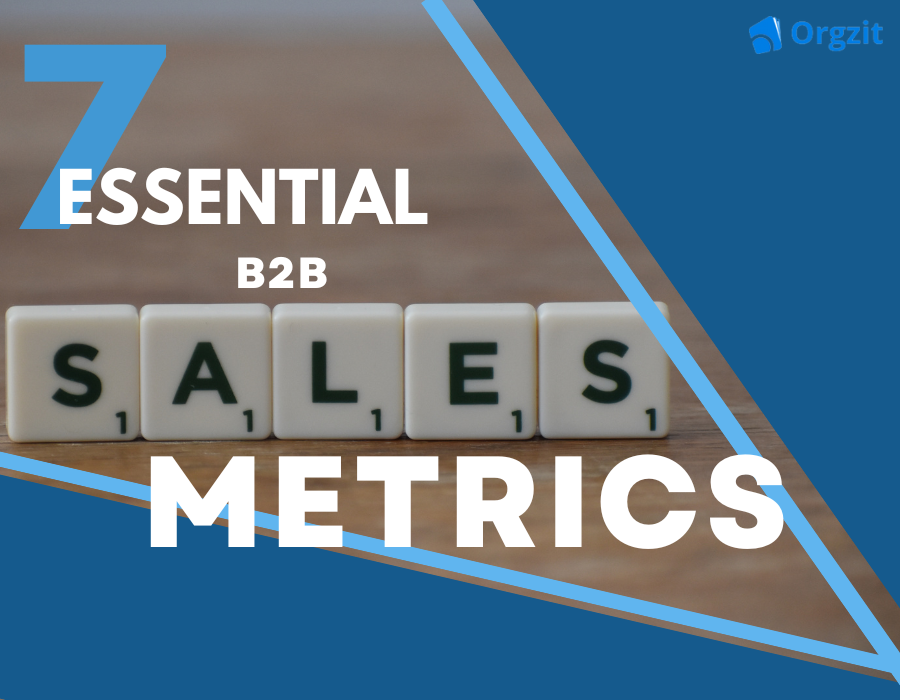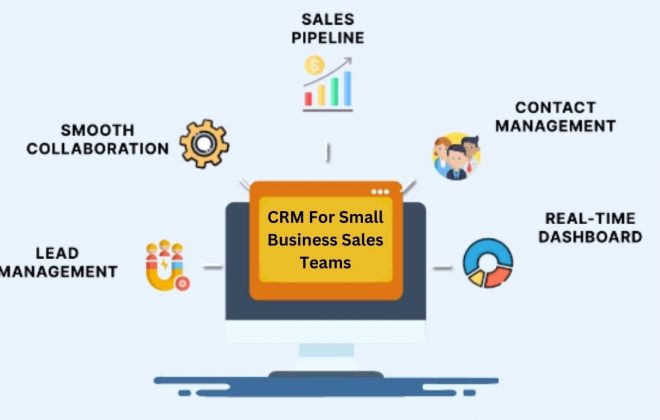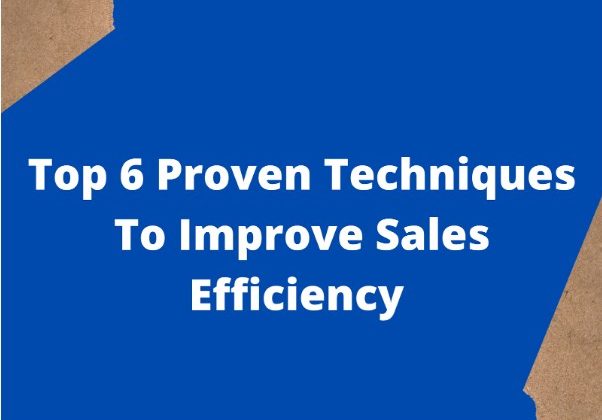7 Essential B2B Sales Metrics for Manufacturers’ Reps
Manufacturers’ reps are critical in driving revenue and forging partnerships in the dynamic and highly competitive world of B2B sales. To excel in this landscape, reps must comprehensively understand their performance and its impact on the bottom line. This is where B2B sales metrics and KPIs come into play, providing tangible performance measures for data-driven decision-making.
This article will explore seven key KPI’s and B2B sales metrics for manufacturers’ reps specifically designed for manufacturers’ reps. These metrics enable reps to assess their sales processes, identify strengths and weaknesses, and optimize strategies for better results. By leveraging these metrics effectively, manufacturers’ reps can enhance sales strategies, improve customer relationships, and achieve revenue goals.
The identified B2B sales metrics and KPIs offer valuable insights into the performance of manufacturers’ reps. Whether monitoring the sales pipeline, analyzing customer churn rate, or measuring sales team productivity, these metrics provide actionable information for driving success.
By tracking these metrics, reps can showcase their value to clients and stakeholders by demonstrating measurable outcomes and return on investment. This not only highlights their effectiveness but also strengthens partnerships.
Throughout the article, we will delve into these B2B sales metrics, providing in-depth knowledge of their significance and practical insights on how manufacturers’ reps can utilize them effectively.
In summary, B2B sales metrics for manufacturers’ reps are essential for manufacturers’ reps to thrive in the competitive B2B sales landscape. By comprehensively understanding their performance and leveraging these metrics, reps can optimize sales strategies, improve customer relationships, and achieve revenue goals. So, let’s dive into these seven key B2B sales metrics and KPIs, exploring their importance and providing valuable insights for success.
Top B2B Sales Metrics to Track
In the fast-paced and competitive world of B2B sales, tracking the right metrics is essential for success. And in this section, we will explore seven key B2B sales metrics and KPIs for sales managers (Key Performance Indicators) that they should track to measure their performance and drive better results.
When setting your Manufacturer’s rep Key Performance Indicators (KPIs), there are several factors to consider. It is important to keep your goals simple and avoid over-complicating them. Additionally, ensure that your goals are relevant by considering how knowing the results will contribute to your growth. Measurability is crucial, as you should be able to track and measure the positive or negative outcomes. While it is beneficial to challenge your business, it is equally important to set achievable goals. Setting unrealistic goals may lead to feelings of discouragement and lack of motivation. Therefore, maintaining a realistic approach is essential to stay motivated and committed to achieving your B2B sales KPIs.
Sales Conversion Rate
The sales conversion rate is a crucial B2B sales metric that tells you how many of your leads or prospects become paying customers. It’s like a barometer for how well your sales process works and how efficient your lead-generation efforts are. By closely monitoring this metric and analyzing it carefully, you can gain valuable insights into your sales performance. And armed with this information, you can make informed decisions to boost your conversion rates and improve your overall sales effectiveness.
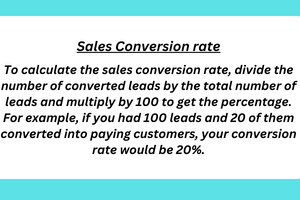

A high sales conversion rate indicates that your sales team is effectively nurturing and closing leads, resulting in a higher percentage of successful conversions. On the other hand, a low conversion rate may suggest that there are inefficiencies in your sales process or that your lead generation strategies need improvement.
Analyzing the factors that contribute to your conversion rate can provide valuable insights. Are your leads properly qualified? Are your sales representatives effectively communicating the value proposition? Are there any bottlenecks in the sales process? By identifying areas for improvement, you can optimize your sales strategy, refine your messaging, and address any obstacles that hinder conversion.
Furthermore, tracking the sales conversion rate over time allows you to monitor the impact of any changes or improvements you make to your sales process. It helps you measure the effectiveness of different lead-generation channels, marketing campaigns, or sales techniques. By experimenting and analyzing the results, you can identify strategies that yield higher conversion rates and replicate them for further success.
Average Deal Size
The average deal size is another crucial B2B sales metric that helps you understand the revenue potential of each customer. By tracking this B2B sales key performance indicator, you can identify opportunities to increase deal sizes through upselling or cross-selling.


Analyzing the average deal size can reveal patterns and trends in your sales efforts. It helps you understand the value customers will invest in your products or services. A high average deal size suggests you successfully sell higher-priced offerings or target customers with more extensive needs.
On the other hand, a small average deal size may indicate that you need to focus on upselling or cross-selling to increase the value of each customer.
Identifying opportunities to increase deal sizes is crucial for revenue growth. By implementing upselling and cross-selling strategies, you can maximize the value derived from each customer relationship.
Upselling involves encouraging customers to purchase higher-priced versions or additional features of your product or service. Cross-selling, on the other hand, involves offering complementary products or services that enhance the value for the customer.
To effectively increase deal sizes, it is important to understand your customers’ needs, preferences, and pain points. You can tailor your offerings by leveraging customer insights and effectively position upsell and cross-sell opportunities to drive additional revenue.
Moreover, tracking the average deal size over time helps you evaluate the success of your sales strategies and identify areas for improvement. By analyzing trends and comparing deal sizes across different customer segments or sales representatives, you can identify best practices, optimize your sales approach, and allocate resources more effectively.
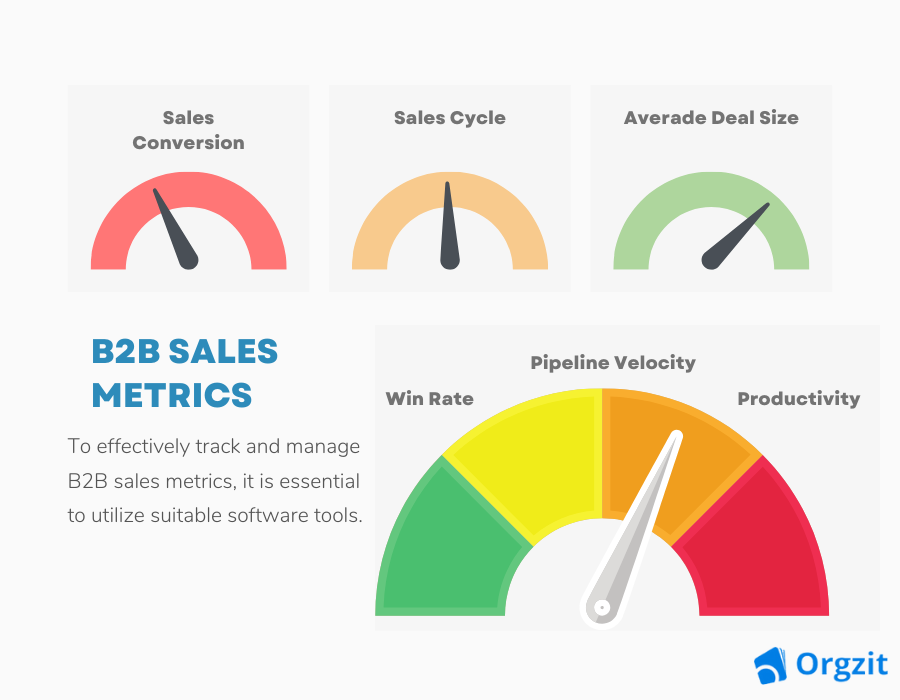

Sales Cycle Length
The sales cycle length is one of the key B2B sales metrics that measure the time it takes from initial contact with a prospect to closing the deal. Tracking this metric allows you to identify bottlenecks in your sales process and make improvements to shorten the cycle and close deals faster.


Analyzing the sales cycle length provides valuable insights into the effectiveness of your sales strategy. A shorter sales cycle indicates that your team efficiently moves prospects through the pipeline and closes deals promptly. On the other hand, a longer sales cycle may indicate bottlenecks or inefficiencies that need to be addressed.
Identifying the factors contributing to a lengthy sales cycle is crucial for improving. Are there delays in responding to prospect inquiries? Are there obstacles or objections that stall the process? Is there a lack of alignment between the sales and marketing teams? By identifying and addressing these bottlenecks, businesses can streamline the sales process, reduce friction, and accelerate deal closure.
Shortening the sales cycle offers several benefits. It allows businesses to generate revenue faster, improve cash flow, and increase sales efficiency. Additionally, a shorter sales cycle enhances the customer experience, as prospects are more likely to convert when they receive timely and efficient support throughout the buying journey.
Tracking the sales cycle length over time enables businesses to monitor the impact of process improvements and changes in their sales strategies. By comparing cycle lengths across different customer segments, products, or sales representatives, businesses can identify best practices and replicate successful approaches to shorten the cycle consistently.
Sales Pipeline Velocity
Sales pipeline velocity is a B2B sales metric that measures the speed at which leads move through your sales pipeline. This B2B sales metric helps you identify areas where leads are getting stuck and where the sales process can be accelerated.


Analyzing the sales pipeline velocity provides valuable insights into the effectiveness of your sales process. A higher velocity suggests that leads are moving swiftly through the pipeline, indicating an efficient and streamlined sales process. Conversely, a lower velocity may indicate areas of concern where leads stagnate or progress.
Identifying the specific stages of the sales process where leads are getting stuck is essential for improving. Is there a bottleneck in lead qualification? Are there delays in responding to customer inquiries or objections? By identifying and addressing these issues, businesses can streamline the sales process, accelerate lead movement, and improve overall sales performance.
Increasing the sales pipeline velocity offers several benefits. It allows businesses to close deals faster, generate revenue more efficiently, and make better use of sales resources. Businesses can maximize their sales opportunities and drive revenue growth by shortening the sales cycle and accelerating lead progression.
Tracking the sales pipeline velocity over time helps businesses monitor the impact of process improvements and changes in their sales strategies. By comparing velocity across different sales teams, products, or customer segments, businesses can identify best practices and replicate successful approaches to consistently increase the speed at which leads move through the pipeline.
Win Rate
The win rate is a B2B sales metric that measures the percentage of deals won compared to the total number of deals pursued.
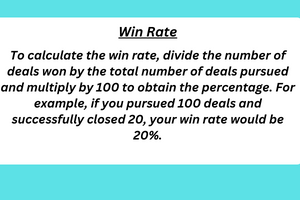

By tracking this B2B sales metric, you can assess your sales team’s effectiveness in closing deals and identify areas for improvement in your sales process or sales training.
Analyzing the win rate allows you to gauge the effectiveness of your sales efforts. A high win rate indicates that your team successfully converts prospects into customers, showcasing the strength of your sales strategy, value proposition, and customer engagement. On the other hand, a low win rate suggests that there may be weaknesses in your sales process, such as ineffective prospecting, poor qualification, or challenges in closing deals.
Identifying areas for improvement in your sales process can lead to increased win rates. For example, refining your lead qualification process can ensure that your team pursues qualified prospects more likely to convert into customers. Improving sales training and equipping your team with effective objection-handling techniques and negotiation skills can also enhance the win rate.
Monitoring the win rate over time helps track the impact of changes or improvements made to your sales process, strategies, or team training. You can identify best practices and replicate successful approaches throughout your organization by comparing win rates across different sales reps, territories, or products.
Increasing the win rate can significantly impact revenue growth. By improving your team’s ability to win deals, you can maximize the value derived from your sales efforts, generate more revenue, and increase market share.
Avg Deal Size By Customer
The average deal size by customer is a key sales metric that provides insights into the average value of deals closed with individual customers. By tracking this metric, businesses can understand the revenue potential of different customers and tailor their sales strategies accordingly.


Analyzing the average deal size by customer offers valuable insights into customer segmentation and profitability. It allows businesses to identify high-value customers who contribute significantly to revenue generation and prioritize them for focused sales and account management efforts. Additionally, it helps identify opportunities to increase the deal size with specific customers through upselling or cross-selling strategies.
Understanding the average deal size by customer helps businesses allocate resources effectively. By identifying customers with a larger average deal size, businesses can allocate more time, effort, and resources to nurture and retain those customers. On the other hand, customers with a smaller average deal size may require a more efficient and streamlined approach to maximize profitability.
Tailoring sales strategies based on the average deal size by customer can lead to improved customer satisfaction and increased revenue. For customers with a larger average deal size, businesses can provide personalized attention, customized solutions, and value-added services to strengthen the relationship and drive customer loyalty. For customers with a smaller average deal size, businesses can focus on operational efficiency, automation, and self-service options to maintain profitability.
Monitoring the average deal size by the customer over time enables businesses to track changes and identify trends. It helps assess the impact of upselling or cross-selling initiatives, pricing or packaging changes, and customer preference shifts. By analyzing these trends, businesses can make data-driven decisions to optimize their sales strategies, maximize revenue potential, and enhance customer relationships.
B2B Sales Team Productivity
Sales team productivity is a B2B sales metric that measures the efficiency and effectiveness of your sales team in generating revenue. By monitoring this B2B sales metric, considering factors such as the number of calls made, meetings conducted, and deals closed by each team member, you can identify top performers and areas where additional training or support may be needed.


Analyzing sales team productivity helps you identify top performers who consistently achieve or exceed their sales targets. Recognizing and celebrating their successes can motivate and incentivize the entire team. Additionally, it allows you to identify areas where additional training or coaching may be required to improve the performance of underperforming team members.
Monitoring sales team productivity also enables you to identify trends and patterns. For example, you may notice that certain team members excel in specific sales activities, such as lead generation or closing deals, while others struggle in certain areas. These insights can inform your sales training and coaching programs, helping you provide targeted support to improve overall team performance.
Additionally, tracking sales team productivity allows you to identify any bottlenecks or inefficiencies in your sales process. For instance, if you notice that a particular team member consistently makes many calls but fails to convert them into meetings or closed deals, it may indicate a need for further training or process optimization.
Regularly analyzing sales team productivity helps you set realistic sales targets, align resources effectively, and make data-driven decisions to improve overall team performance. It enables you to identify best practices, replicate successful approaches, and allocate resources strategically to maximize revenue generation.
Choosing the Right Software for Managing B2B Sales Metrics for Manufacturers’ Reps
To effectively track and manage B2B sales metrics, it is essential to utilize suitable software tools. These tools provide the necessary capabilities to monitor and analyze sales performance, enabling businesses to make informed decisions and drive better outcomes. Here, we will explore the importance of utilizing software tools for effective metric tracking and compare some of the leading CRM software options available in the market.
Importance of Utilizing Software Tools for Effective Metric Tracking
Manually tracking B2B sales metrics for manufacturers’ reps can be a daunting and time-consuming task. Using specialized software tools streamlines the process and offers several advantages. These tools provide a centralized platform for managing and analyzing sales data, making tracking key metrics and deriving actionable insights easier. By automating data collection and analysis, software tools eliminate the risk of human error and ensure accurate and reliable metrics.
Moreover, software tools offer features and functionalities specifically designed for B2B sales metric tracking. They provide customizable dashboards, reports, and visualizations that enable businesses to monitor real-time performance and identify trends or patterns. With the ability to set alerts and notifications, these tools ensure businesses stay informed about any significant changes or deviations from target metrics.
Comparison of Leading CRM Software Options in B2B Sales Industry
When choosing the right software for managing B2B sales metrics for manufacturers’ reps, several CRM (Customer Relationship Management) solutions stand out in the market. Let’s take a look at some of the leading options:
Orgzit CRM for Manufacturers’ Reps
- Pros:
- Comprehensive CRM system with features like sales pipeline management and sales analytics.
- User-friendly interface that is easy to navigate.
- Customizable to fit specific business needs.
- Offers collaboration and team management capabilities.
- Provides a cost-effective solution for small and medium-sized businesses.
- Strong customer support
- Cons:
- It may not have as extensive third-party integrations as other CRM platforms.
- Advanced features may require technical expertise for customization.
HubSpot CRM
- Pros:
- Free CRM software with basic features that are suitable for small businesses.
- Seamless integration with other HubSpot marketing and sales tools.
- User-friendly interface and easy to set up.
- Provides a visual sales pipeline for easy tracking.
- Offers additional features for marketing automation.
- Cons:
- Advanced features require a subscription to HubSpot’s paid plans.
- Limited customization options for more complex sales processes.
- Reporting capabilities may be limited compared to more robust CRM solutions.
- Users have reported occasional system performance issues and slower loading times.
- Certain advanced features, such as custom objects or complex sales processes, may not be supported.
- The free version has limitations in terms of storage and features, requiring a paid plan for more extensive usage.
Salesforce Sales Cloud
- Pros:
- Feature-rich CRM platform with extensive customization options.
- Highly scalable and suitable for businesses of all sizes.
- Robust reporting and analytics capabilities.
- Integrates with a wide range of third-party applications.
- Offers a large community and marketplace for add-ons and extensions.
- Cons:
- Steeper learning curve compared to some other CRM platforms like Orgzit CRM.
- Pricing can be expensive, especially for small businesses.
- Requires technical expertise for advanced customization and configuration.
- The extensive range of features and capabilities offered by Salesforce can sometimes be overwhelming for users who only require basic CRM functionalities.
- Slower response times or difficulties in reaching the support team for assistance.
Pipedrive
- Pros:
- Intuitive and user-friendly interface.
- Focuses specifically on sales pipeline management.
- Offers visual sales pipeline and customizable stages.
- Provides mobile apps for on-the-go access.
- Affordable pricing plans for small and medium-sized businesses.
- Cons:
- Limited advanced features compared to more comprehensive CRM platforms.
- Integration options may be more limited compared to other tools.
- Reporting capabilities may not be as robust as some other CRM solutions.
- Limited automation capabilities
Zoho CRM
- Pros:
- Comprehensive CRM solution with extensive customization options.
- Offers a wide range of sales, marketing, and customer service features.
- Affordable pricing plans for businesses of all sizes.
- Integrates with other Zoho suites of products.
- Provides a marketplace for additional extensions and integrations.
- Cons:
- The user interface can be overwhelming for new users.
- Advanced features may require additional configuration and setup.
- Support response time can vary.
- Some users find the interface outdated and less intuitive compared to other modern CRM platforms.
- Integrations with certain third-party applications may require additional configuration or setup.
- While Zoho CRM offers extensive features, some users find that certain advanced functionalities can be complex to set up and configure.
Microsoft Dynamics 365 Sales
- Pros:
- Comprehensive CRM platform.
- Seamlessly integrates with other Microsoft products and services.
- Provides advanced analytics and reporting capabilities.
- The scalable solution is suitable for businesses of all sizes.
- Offers industry-specific solutions and templates.
- Cons:
- Requires expertise in Microsoft technologies for customization and configuration.
- Pricing can be higher compared to some other CRM platforms.
- The steeper learning curve, especially for users unfamiliar with Microsoft products.
- Higher learning curve and complexity compared to more user-friendly CRM platforms.
- Some users find the user interface overwhelming and require time to navigate the system proficiently.
- The pricing structure can be complex, with additional costs for add-ons, customization, and certain features.
Benefits and Considerations of Each Software Tool
Each CRM software option mentioned above offers unique features and advantages. Businesses must consider their specific requirements and preferences when selecting a software tool. Budget, scalability, customization needs, and integration capabilities should be considered. It is also essential to evaluate the technical expertise available within the organization for implementing and customizing the software.
Businesses can effectively manage and track their B2B sales metrics by choosing the right software tool, gaining valuable insights, and driving better results.
Wrapping Up,
In conclusion, tracking the right B2B sales metrics for manufacturers’ reps is crucial for evaluating and improving sales performance. By consistently monitoring these sales key performance indicators to track, businesses can gain valuable insights into their sales processes, identify areas for enhancement, and make data-driven decisions to drive better results.
Businesses can leverage advanced CRM systems like Orgzit to streamline sales processes and track sales performance. Orgzit CRM system provides a comprehensive solution for managing and tracking sales metrics.
By utilizing an efficient CRM system, businesses can align their sales efforts with key KPIs, continuously track their progress, and drive better outcomes.
In today’s highly competitive business landscape, tracking sales performance is essential for staying ahead and maximizing revenue opportunities. Businesses can improve their sales effectiveness, enhance customer satisfaction, and achieve their growth objectives by utilizing the right tools, such as the Orgzit CRM system, and focusing on the identified B2B sales KPIs.
Tracking sales metrics with the right CRM system empowers businesses to make informed decisions and drive better sales outcomes.
Schedule a demo today to learn more.


